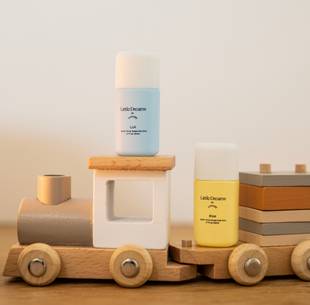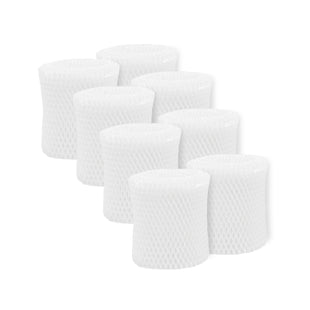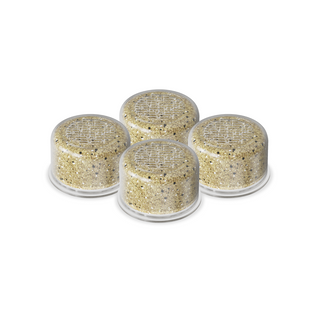The water that comes through your tap is filtered, but this filtration process doesn’t remove every impurity. Tap water contains chlorine, dissolved minerals1, and other contaminants that can cause dry, itchy skin and hair, unpleasant tastes and odors, and chalky hard water stains.
For homeowners tackling water contamination, filters offer a cost-efficient solution. These devices use a variety of water treatment techniques, but granular activated carbon (GAC) is a particularly effective method. GAC is known to reduce bad odors, chlorine, and other contaminants from water—and it’s the key to Canopy’s results.
What Is Granular Activated Carbon and How Does It Work?

Granular activated carbon is a filtering media made from raw organic materials that are high in carbon, such as coconut shells, coal, or wood. Coconut shell is considered the most sustainable of these three materials2. GAC media is highly porous and features a large surface area, allowing these filters to trap contaminants more efficiently than traditional filters.
While it sounds technical, the filtration process is rather simple. When tap water passes through the granulated activated carbon water filter, contaminants are adsorbed into the media and held there. GAC media is especially effective for catching rapidly diffusing gases and vapors2.
Activated carbon filters work in one of two ways: physical adsorption or chemical reactions. The main avenue of filtration is physical, where contaminants are drawn into the pockets of the GAC media through intermolecular forces, much like how magnets work. Adsorption is a process where substances adhere to a surface and create a film. The porosity and expansive surface area of granular activated carbon filters create plenty of spaces for contaminants to get caught as water flows through—and the tinier the pores, the more thorough the filtration3.
A common chemical reaction in granulated activated carbon water filters involves chlorine. When there is chlorine in tap water, it will react with activated carbon to form non-toxic chloride ions, reducing the chlorine4. This results in cleaner, fresher water.
What Substances Can Granular Activated Carbon Filter Out?
A granulated activated carbon water filter can reduce contaminants that affect the taste, odor, and hardness of the water. This includes:
-
Chlorine: Produces a strong odor and can lead to dull hair, flaky scalp, brittle nails, and patchy, irritated skin. If you have light-colored or dyed hair, chlorine can also cause discoloration. The water may look rusty brown or green, depending on the dissolved metals also present.
-
Hydrogen Sulfide: Creates an unpleasant taste and odor in tap water often compared to rotten eggs5.
-
Dissolved Minerals: Municipal water is generally sourced from the ground or surface water, so it naturally contains some dissolved earth minerals. These contaminants have a similar effect on your skin and hair as chlorine, leaving skin feeling tight and itchy and hair dry and prone to breakage.
In most municipal water sources, the level of these contaminants won’t be a health or safety concern—but they can still affect your skin and hair and the overall experience of washing up. If you want to reduce impurities, a GAC filter can help. Installing a granular activated carbon filter gives you water that looks, smells, and tastes better. Filtered water also supports healthy, hydrated skin, making it a part of the ultimate skincare routine.
Enjoy Clean, Filtered Water With Canopy
Today, more homeowners than ever see the importance of filtering their drinking water, but they often overlook the shower. Contaminants in tap water can affect your skin and hair, but an effective water filter like Canopy’s dermatologist-recommended showerheads will help you start your day feeling cleaner and fresher than ever.
But we’re not done making your home hydration experience better. Want to be in the loop for our upcoming product launches? Sign up for our email list or follow us on TikTok, Instagram, or Facebook.
Sources:
-
Carollo, R. Survey Reveals Why More Americans Than Ever Are Filtering Their Water. Aquasana. Retrieved February 22, 2025, from https://www.aquasana.com/info/survey-reveals-increasing-popularity-of-water-filters-pd.html
-
Use of Coconut Shell Activated Carbon in Water Filter. Karbonus, Inc. Retrieved February 22, 2025, from https://www.karbonous.com/blog/use-of-coconut-shell-activated-carbon-in-water-filter/
-
Campbell, B. (17 March 2022). What Is Activated Carbon Filtration? WaterWorld. Retrieved February 22, 2025, from https://www.waterworld.com/residential-commercial/article/14306945/what-is-activated-carbon-filtration
-
Woodard, J. (27 November 2023). Activated Carbon Filters 101. Fresh Water Systems. Retrieved February 22, 2025, from https://www.freshwatersystems.com/blogs/blog/activated-carbon-filters-101
-
Swistok, B. (10 December 2024). Hydrogen Sulfide (Rotten Egg Odor) in Water Wells. Penn State Extension. Retrieved February 22, 2025, from https://extension.psu.edu/hydrogen-sulfide-rotten-egg-odor-in-water-wells
























